Gumroad vs. Shopify (+ dealbreakers) – decide in 7 minutes

Are you looking for the best eCommerce platform for selling digital products online?
There are so many choices out there it’s easy to get confused, especially when every platform has its pros and cons.
For instance, should you pick Gumroad or Shopify? Or, maybe a different online platform?
The truth is that both Gumroad and Shopify are pretty similar (in a way), so we’re not going to waste your time by comparing every single feature. Instead, we’ll focus on the key differences and main dealbreakers to help you come to a final decision.
So, which eCommerce platform is right for you? Let’s find out.
Quick breakdown: Gumroad vs. Shopify
Gumroad and Shopify are both hosted eCommerce platforms for selling digital or physical products. But, there are some major differences between them.
The biggest difference is that Gumroad isn’t as complex as the Shopify platform when it comes to building an online store.
Gumroad is about as basic as you can get—it has less features and integrations, which makes it very simple and easy to use.
This is why Gumroad tends to be more popular with beginners and small businesses that only sell a few products.
Gumroad is also known for making it easy to add and sell digital products. With Shopify, you’ll need to use external apps or services to sell digital goods.
However, even though Shopify isn’t as easy as Gumroad, it offers a couple of features that Gumroad doesn’t have: app integrations, store themes, and the possibility to sell services.
Still, Gumroad has one key advantage over Shopify: a free plan. With Gumroad, you don’t need to pick a paid plan to start selling digital products online whereas with Shopify, you can only get a 3-day free trial.
Read on to learn more about the similarities and differences between Gumroad and Shopify: their potential dealbreakers, key features, etc.
To help you see how the two platforms compare to each other as well as other competitors, we’re also going to cover a third eCommerce platform—Sellfy.
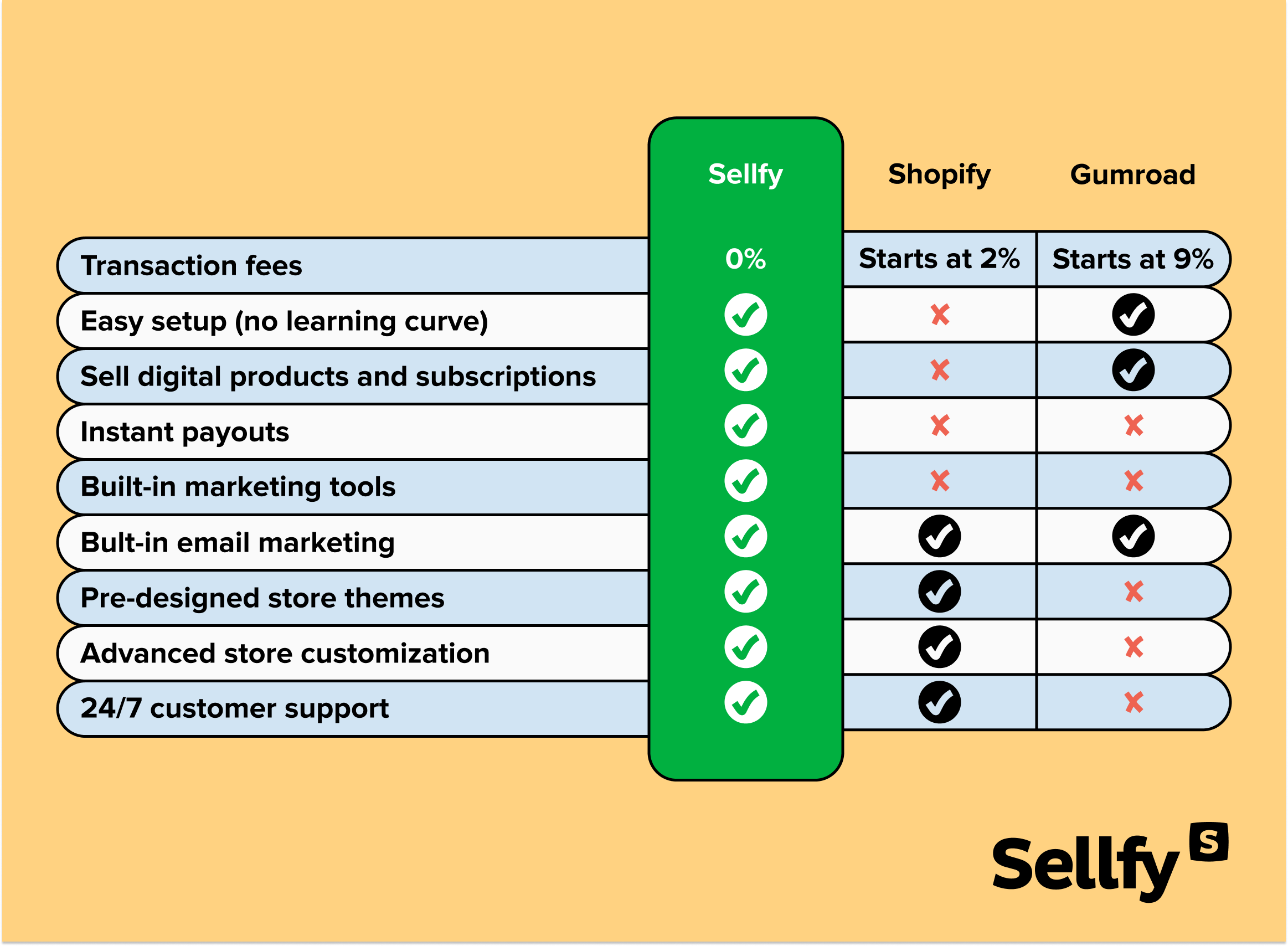
Gumroad and Shopify are similar (in a way)
Gumroad and Shopify were built for digital creators looking for an eCommerce solution.
Both solutions allow you to easily create and sell products online, whether it’s on a basic hosted storefront (Gumroad) or a complex eCommerce store with multiple integrations (Shopify).
Also, both offer a way for you to market your digital products with a few built-in features.
However, aside from the similarities and the fact that both platforms serve the same goal, there are some key differences worth considering before you make a final choice.
Why would you choose Gumroad over Shopify?
As much as we appreciate Shopify’s complexity and vast selection of apps, there are some pretty good reasons for you to pick Gumroad over Shopify. Let’s check them out.
1. Gumroad is an easier eCommerce platform for selling digital products
The number one reason is that Gumroad is a much easier platform for people that are new to eCommerce and simply want to sell digital goods.
There is no deep learning curve, or having to figure out how this or that works. The steps to set up an online store are pretty straightforward—no coding or design skills required.
You also don’t need to use several paid app integrations or external services to sell digital items.
With that being said, this type of simplicity may feel limiting after a while, especially when you’ve become used to running an eCommerce store and need more flexibility.
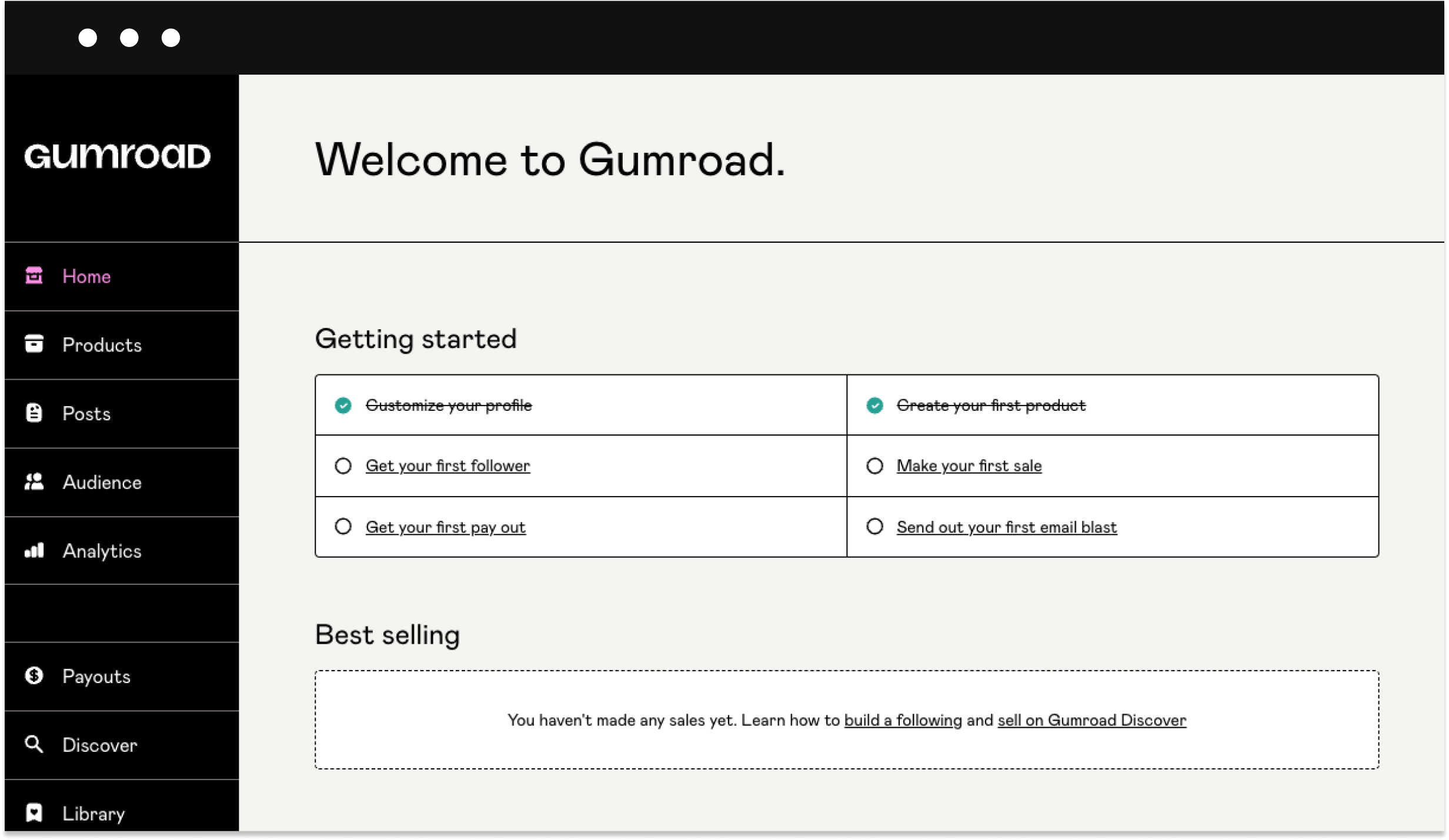
2. People can find your products on the Gumroad Discover marketplace
Gumroad Discover is a unique feature that recommends your digital products to potential customers browsing its marketplace.
So, if you’re looking for a way to sell and market digital products without an existing social media presence, then Gumroad might work for you.
However, you’ll need to be ready for the 10% transaction fee that Gumroad takes for every sale you make on the marketplace.
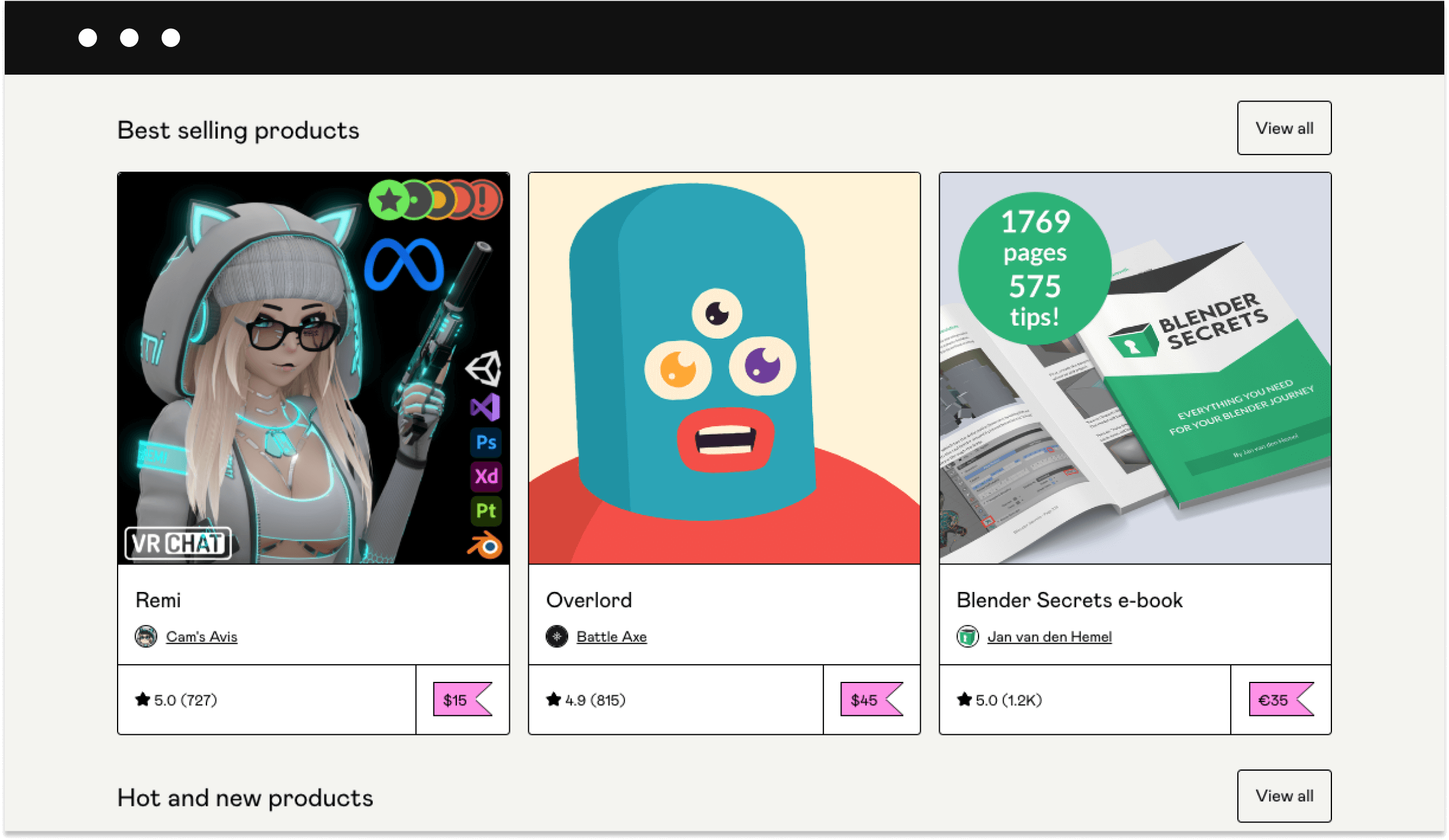
3. Gumroad has a free plan for selling products online
Unlike Shopify, Gumroad has a free plan that lets you sell your digital products without having to commit to a paid subscription.
This is great for anyone who wants to sell online and has a limited budget.
Some of the best perks of Gumroad’s free plan include selling an unlimited number of digital products, customer management, store analytics, and SD streaming.

The main disadvantages of Gumroad
However, aside from Gumroad’s perks, there are also a couple of dealbreakers that you should be aware of.
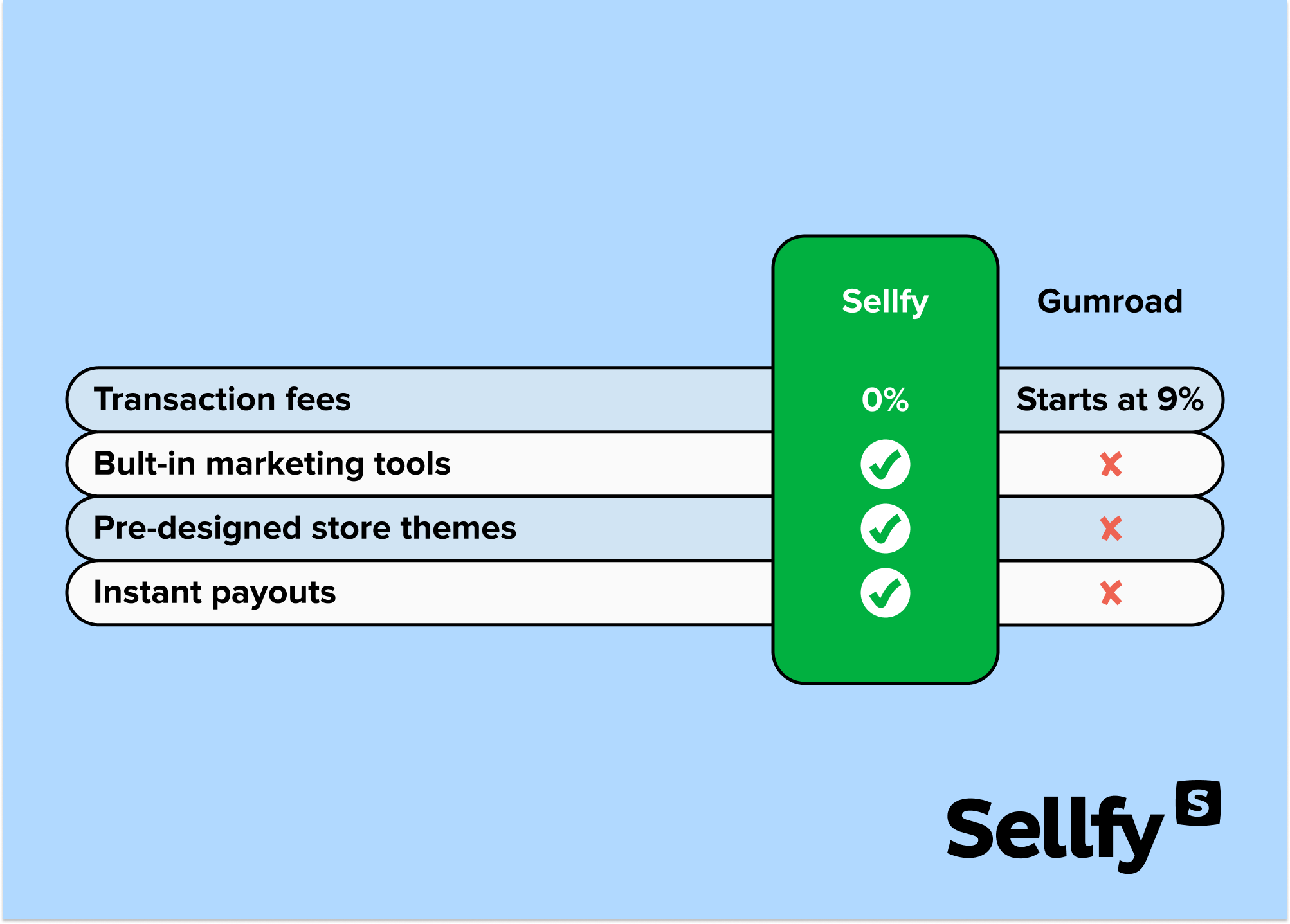
Let’s talk about some of them in more detail.
1. Transaction fees are higher than payment gateway fees
Although Gumroad has a free plan, it doesn’t mean that it’s 100% free.
Gumroad takes a 9% + 30¢ cut of your sales when you first start selling digital products, which is even more expensive than payment gateway fees.
For example, the PayPal Checkout rate for receiving domestic transactions is 3.49% + 0.49 USD—much lower than Gumroad’s transaction fee. This means that you’ll lose quite a significant amount of your hard-earned money.
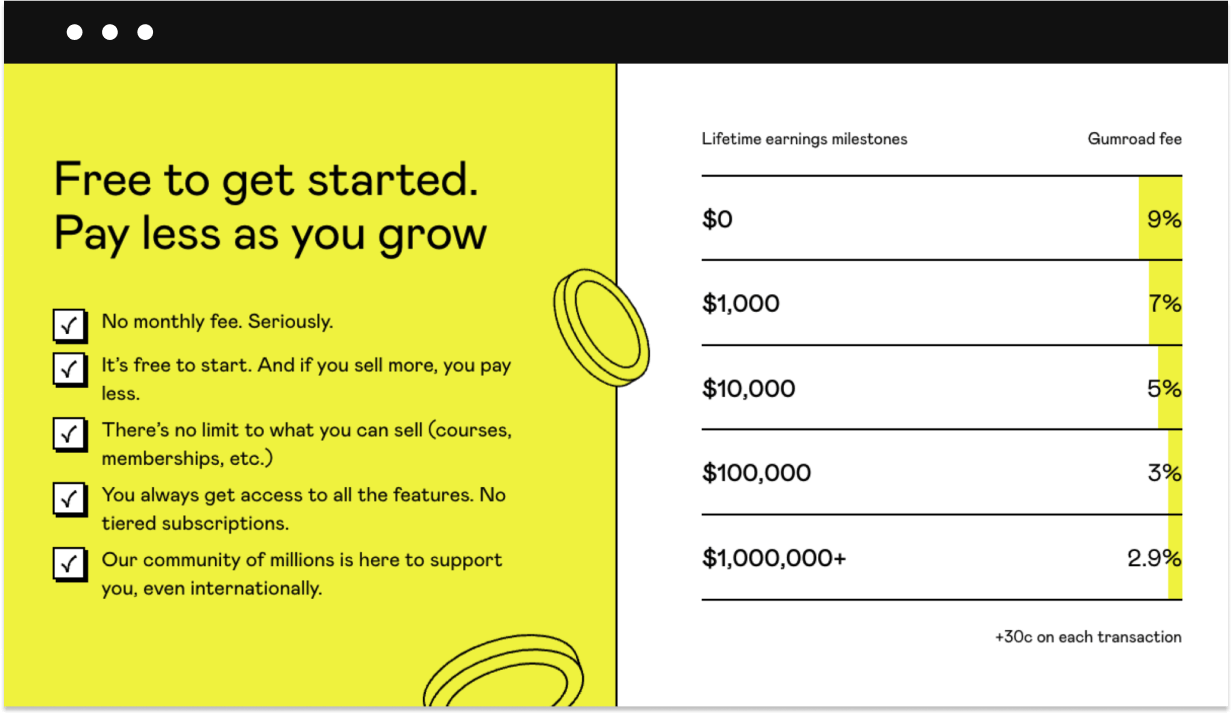
2. You’ll have the same basic store design as everybody else
With Gumroad, you can hardly customize anything at all. There are no store themes to choose from, which means that your page will look like all the other checkout pages on Gumroad.
Yes, you can still add some custom fields here and there to create a custom domain and product categories, and change some colors, but that’s about it.
Any advanced customization of your Gumroad store will require CSS/HTML skills.
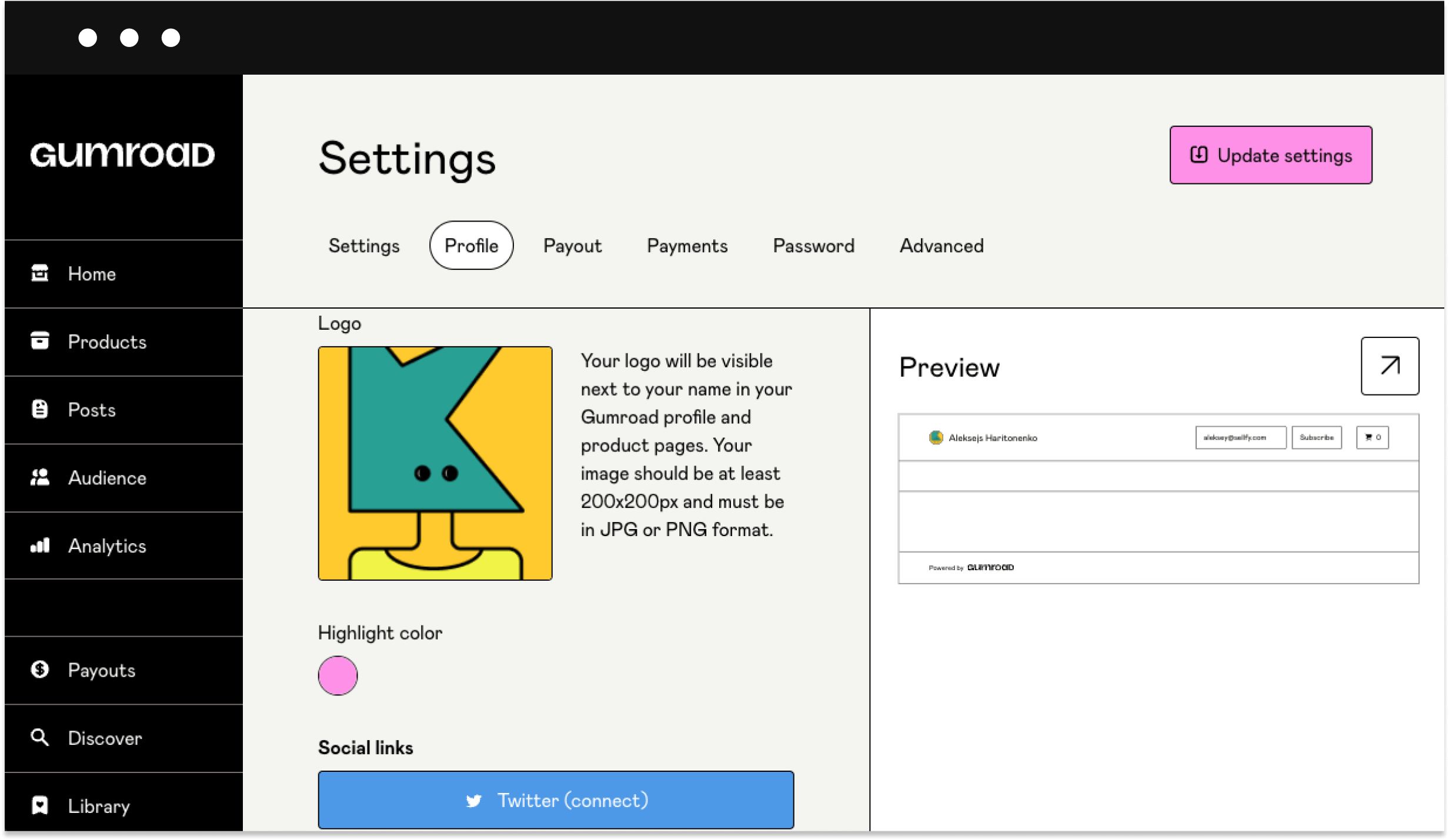
3. No built-in marketing tools to grow your online business
It’s possible to build an email list and issue discount codes, but that’s all you can really do with Gumroad.
Unlike Shopify, Gumroad doesn’t offer any other built-in marketing features.
So, you won’t be able to use SEO tools to attract customers, act on your customer data, track sales or seller analytics, craft advanced digital marketing campaigns, etc.
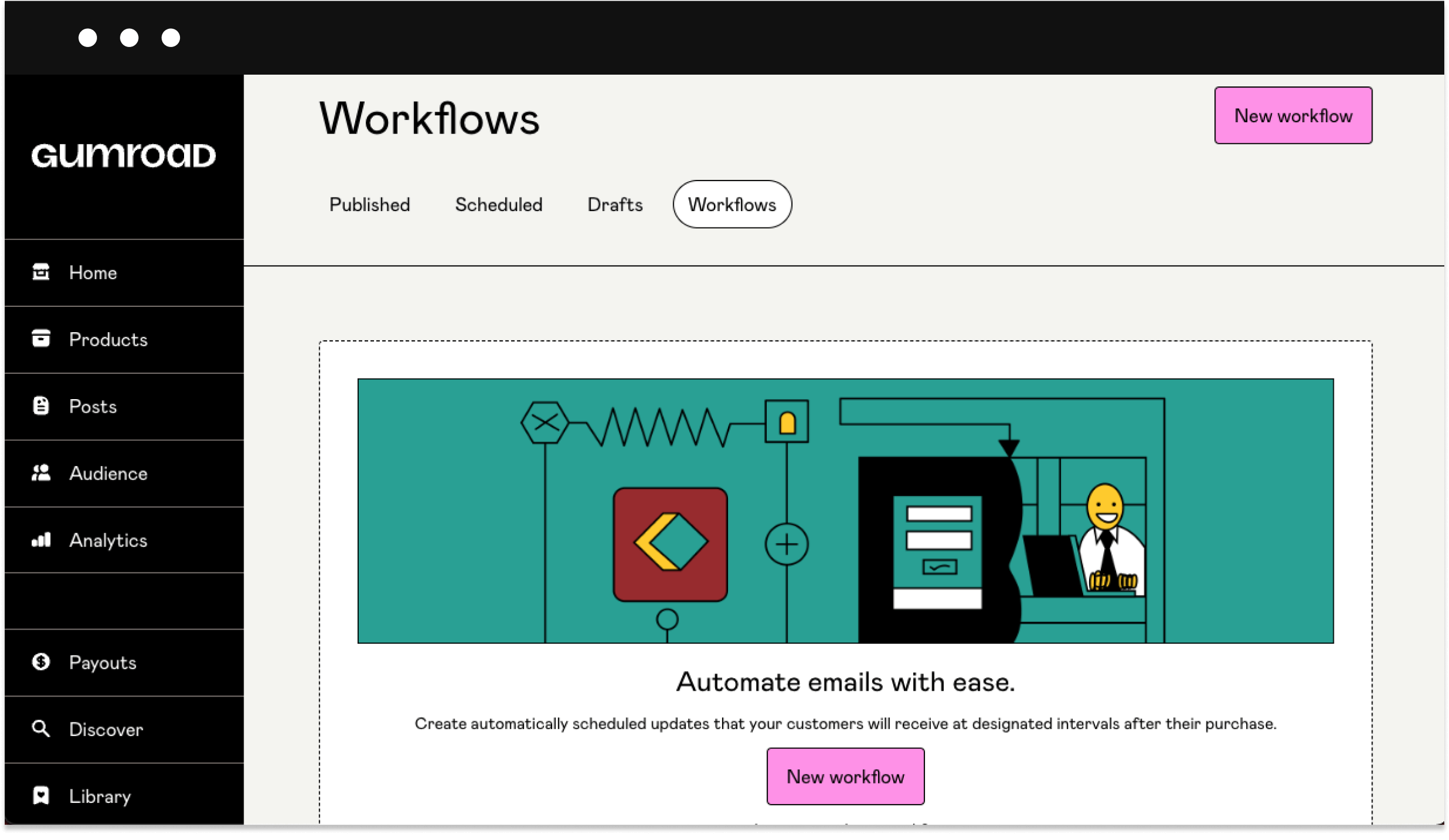
4. Limited payment methods & no instant payouts
Gumroad processes payouts weekly, with a $10 minimum balance requirement. Since PayPal is no longer supported, creators are now limited to bank transfers, which aren’t available in all regions (they’re only available in the UK, US, Canada, and Australia).
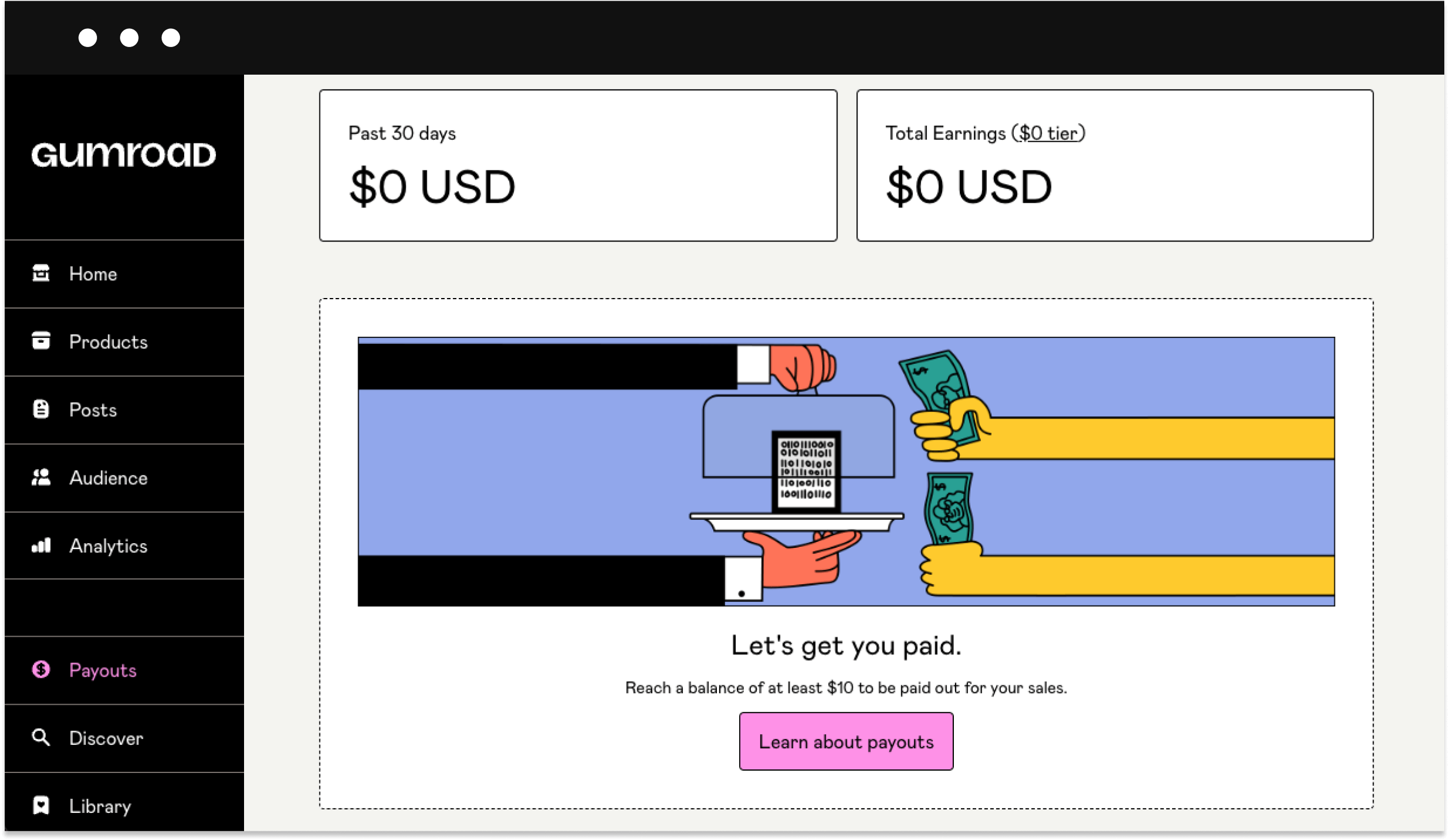
5. Forget Gumroad if you want to sell services
If you’re a creator who wants to sell online courses, services, or coaching, then it’s probably best to cross Gumroad off your list and find another eCommerce platform.
The only thing that you’ll be able to sell, aside from physical products, is digital downloads or memberships. Depending on what type of business you have, that may or may not meet your personal needs.
Why would you choose Shopify over Gumroad?
Shopify is far from being the only alternative to Gumroad, but it’s definitely an option worth considering.
Let’s explore why.
1. Flat pricing & no transaction fees with Shopify Payments
While Shopify doesn’t have a free plan like Gumroad, it does have more transparent (and less confusing) monthly and yearly pricing plans:
- Basic (24 EUR/mo or 252 EUR/y)—basic reports, 2 staff accounts, up to 4 inventory locations.
- Shopify (69 EUR/mo or 744 EUR/y)—professional reports, 5 staff accounts, up to 5 inventory locations.
- Advanced (289 EUR/mo or 3084 EUR/y)—custom report builder, 15 staff accounts, up to 8 inventory locations.
Moreover, Shopify store users can receive payouts via Shopify Payments—a unique feature that makes it possible to accept payments without a third-party payment provider.
In addition, Shopify users can either set up their own payment schedule, or simply receive their payouts within 1-3 business days.
However, keep in mind that Shopify Payments is only available to stores in certain locations. So, if Shopify Payments isn’t available to you, then you will need to use a third-party payment provider.
This means that you’ll have to pay additional credit card or payment gateway fees (of 2%, 1%, and 0.5% for the Basic, Shopify, and Advanced plans).

2. You can customize your online store with free or paid themes
This is where Shopify has the upper hand over Gumroad—the platforms lets its users customize their stores how they want.
There are thousands of Shopify themes out there (both paid and free, but mostly paid) sold on online marketplaces like Creative Market, Envato Market, and so on. This may be ideal for someone who truly wants a unique store.
But, some of the themes can be quite expensive (the cheapest ones usually cost $19), so if you’re just starting out, then it may be better to use a free Shopify theme (the selection is rather limited, though).
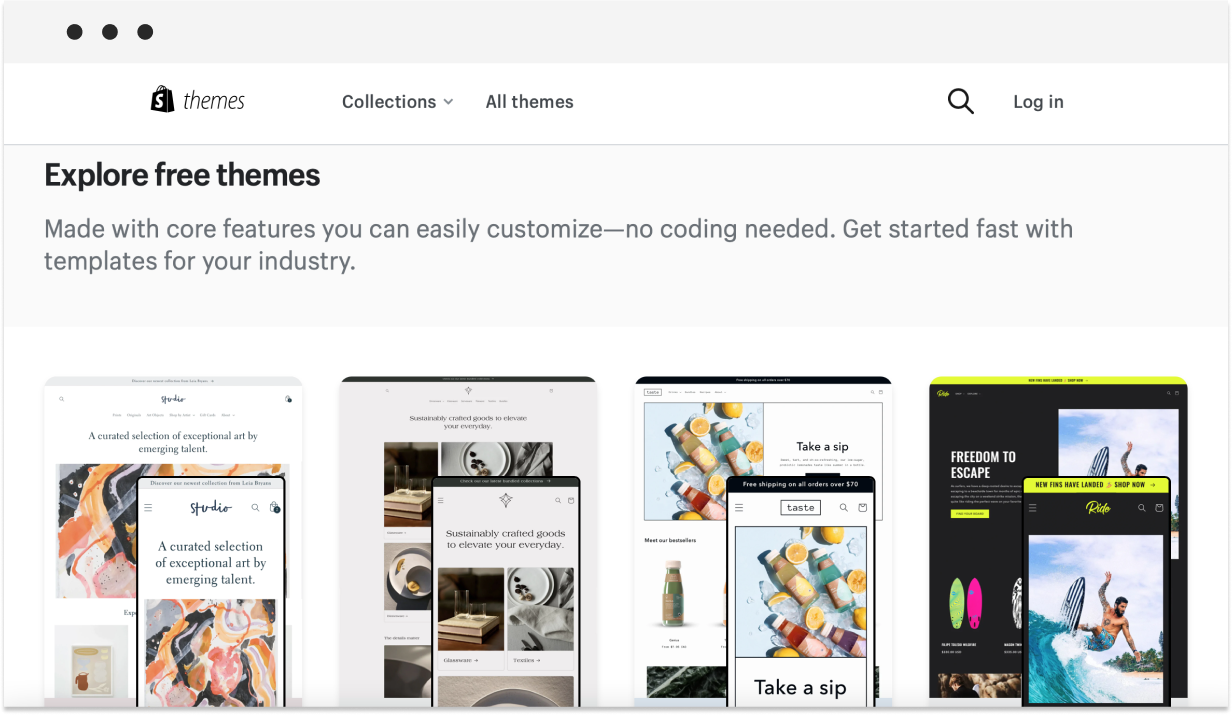
3. You can build a complex online platform with app integrations
Not only do you have the freedom to choose a theme, but you can also build a complex eCommerce store with the addition of app integrations.
Shopify has hundreds of apps available on the Shopify App Store. There are apps for different purposes such as email, SEO, social media channels, AliExpress dropshipping, and more.
This is obviously great for a a high-volume seller that wants a store without limitations. But, it’s worth keeping in mind that this could also end up making your store heavily bloated with apps.

The main disadvantages of Shopify
Shopify may look like a slightly better alternative to Gumroad, but it’s far from being the best eCommerce solution available. 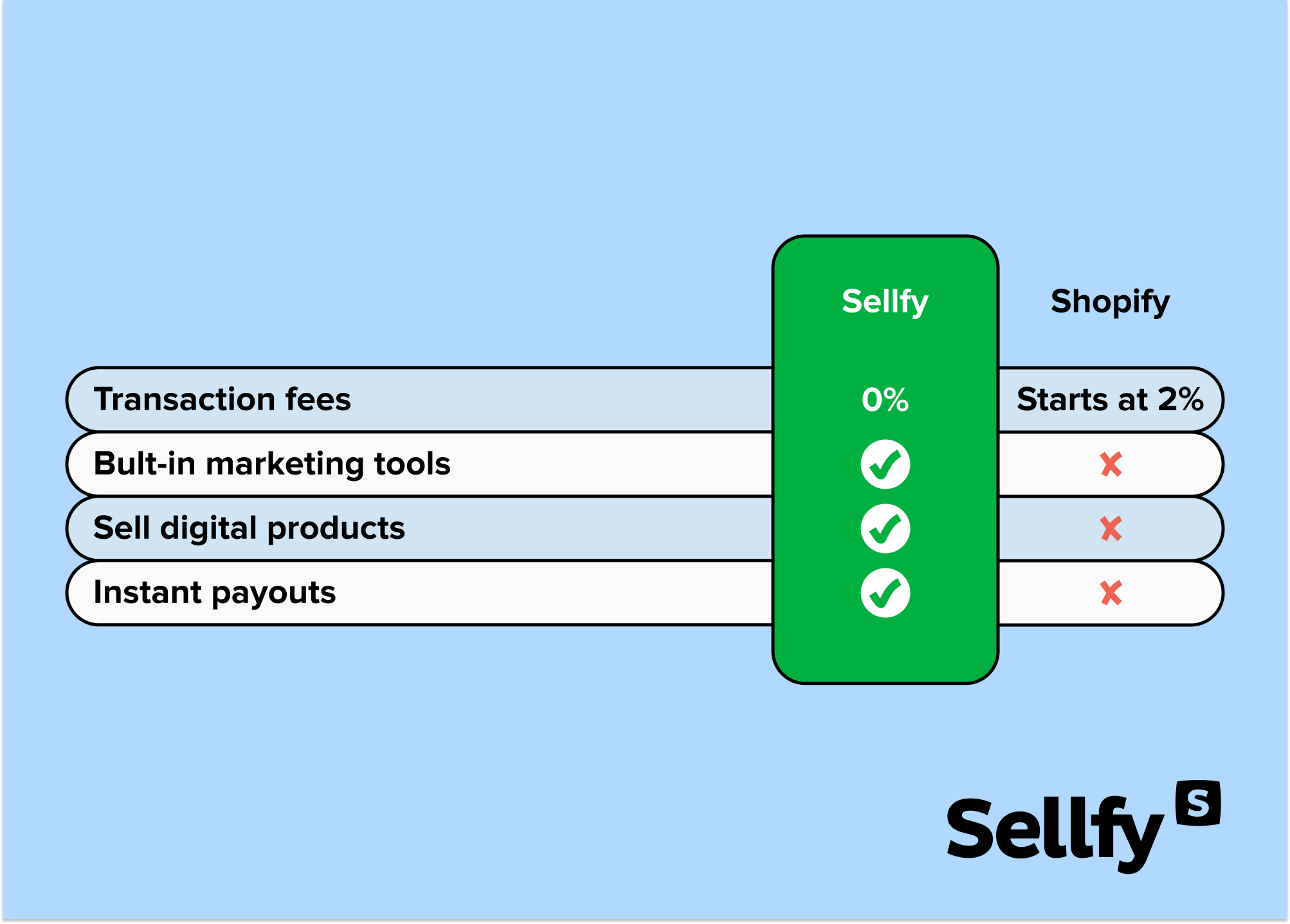
So, let’s get into the dealbreakers.
1. Shopify isn’t a cost-effective platform for beginners
Despite Shopify’s flat pricing (something that Gumroad lacks), it is still quite expensive, especially for a beginner with a limited budget.
While Shopify does make up for it with the many app integrations, themes, and other external services, some of the tools still require considerable financial investment.
Also, keep in mind that even though Shopify offers an alternative solution for beginners (a 5 EUR/month Starter plan), it only lets you sell through social and messaging apps.
There’s no actual website or complex storefront, just a product page link that you can add to your bio.
Of course, it’s entirely possible to use Shopify without any of the paid stuff, but most users will still end up paying for something extra one way or another.
And, in the end, all of these costs and monthly fees can add up.
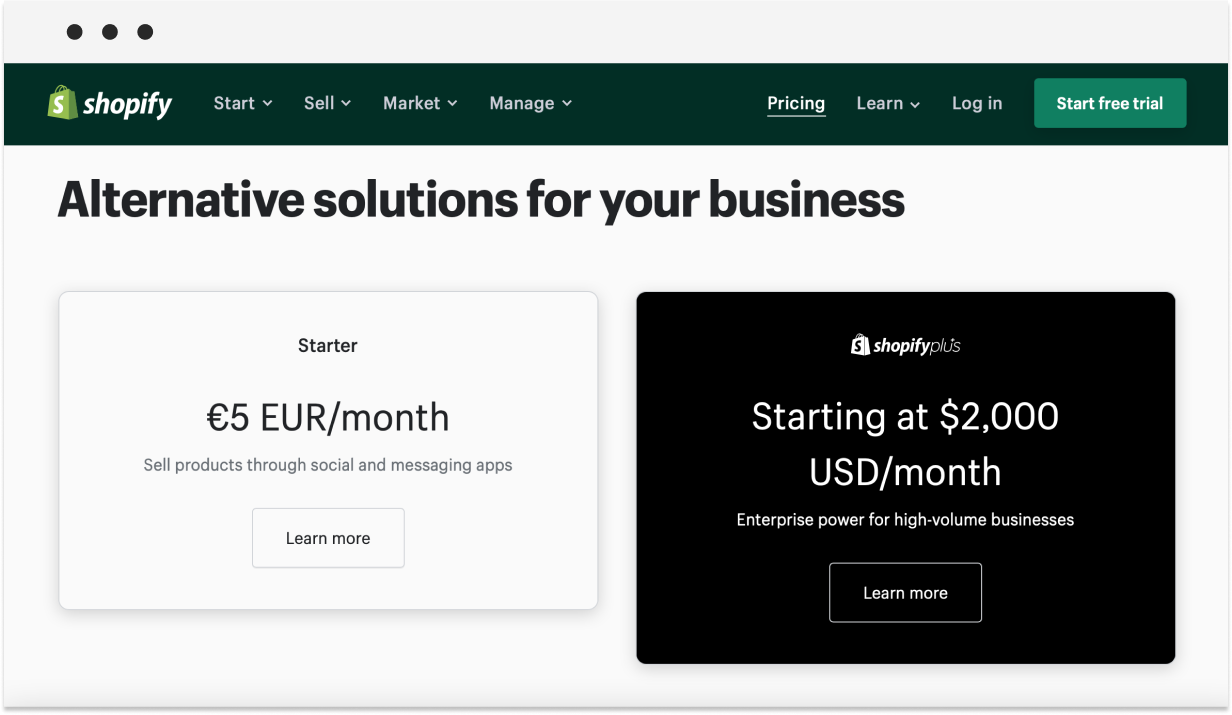
2. You must rely on third-party apps to sell digital products
Another downside is that it isn’t exactly possible to sell digital items without third-party apps and services.
This could be a major dealbreaker for a beginner who wants a simple solution that gets the job done without having to rely on external services.
Yes, Shopify lets you use apps and services to manage different aspects of your online business, but it doesn’t change the fact that none of these are built-in features.
In other words, you might have to pay for some of the external services.
Do you really want a solution that is so heavily reliant on third-party applications?
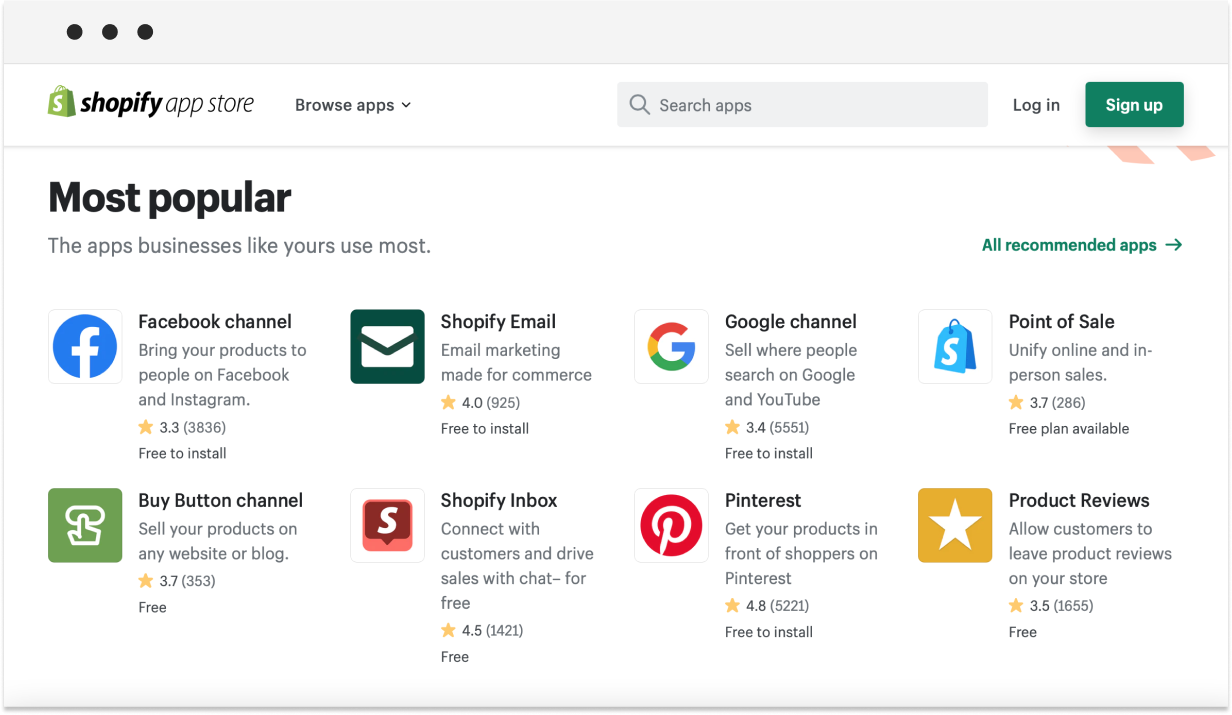
3. Shopify comes with a steep learning curve
And, last but not least, Shopify is probably one of the least beginner-friendly platforms out there.
While Shopify does have a Help Center where you can find user guides, much of your time will still be spent on learning everything through trial and error—from setting things up to navigating the user interface.
A lot of it can be so complex that some users end up switching to simpler platforms.
Sellfy creator EfikZara concurs:
I used to have a Shopify store, but it’s not as user-friendly as Sellfy. When you’re selling something like digital products, I think it should be straightforward so that your customers can get what they need.
The question isn’t Gumroad vs. Shopify—it’s why not Sellfy?
By now, you should have a clear understanding of what both platforms offer.
If you’re looking for a simple storefront for selling digital products, then Gumroad may be worth a try. However, if you’re looking for a more complex and customizable solution that offers app integrations, then Shopify could be the better option.
In any case, both platforms come with some serious dealbreakers, which is why I’d like to introduce you to Sellfy.
1. Setting up your Sellfy store takes as little as 10 minutes
Unlike Gumroad and Shopify, setting up a Sellfy store is a piece of cake thanks to the user-friendly interface. The best part is that you don’t need any previous experience at all.
All you have to do is upload your product, add a description and a price—that’s it!
And, then you can start playing around with customization options or pick one of our beautiful pre-designed store themes.
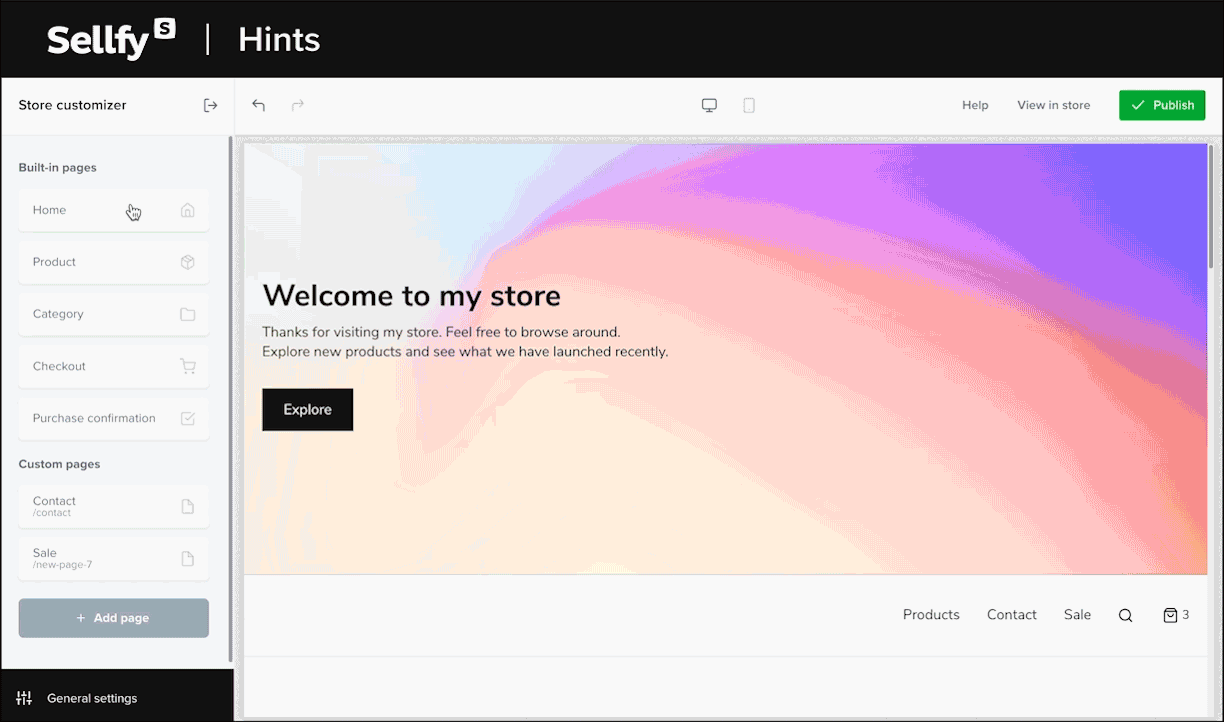
2. You get advanced features & built-in marketing tools
Both Gumorad and Shopify offer the absolute bare minimum when it comes to built-in marketing features.
Many of their features are just external apps or services (that you have to pay for).
Sellfy has everything you need to grow your business, including powerful built-in marketing tools like email marketing, discounts, coupon codes, upselling, cart abandonment, pay-what-you-want pricing, and so much more.
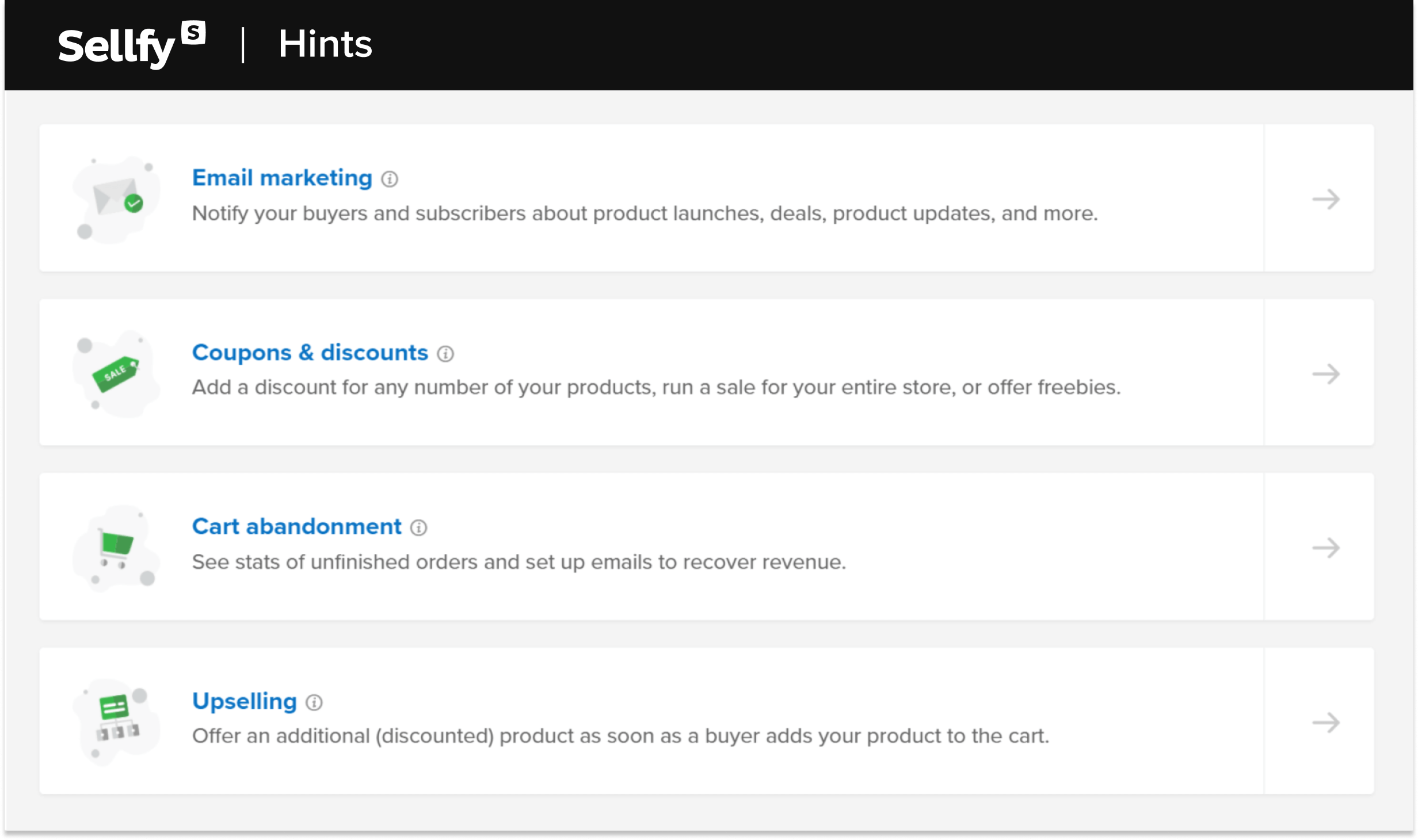
3. You can say goodbye to transaction fees
No transaction fees whatsoever!
This means that you can focus on selling without worrying about anything eating your profits. Your only expense will be your monthly (or yearly) subscription plan.
With Sellfy, you can sell unlimited products, use built-in marketing features, enjoy advanced store customization, and even use print-on-demand without hidden transaction fees on any of the plans.
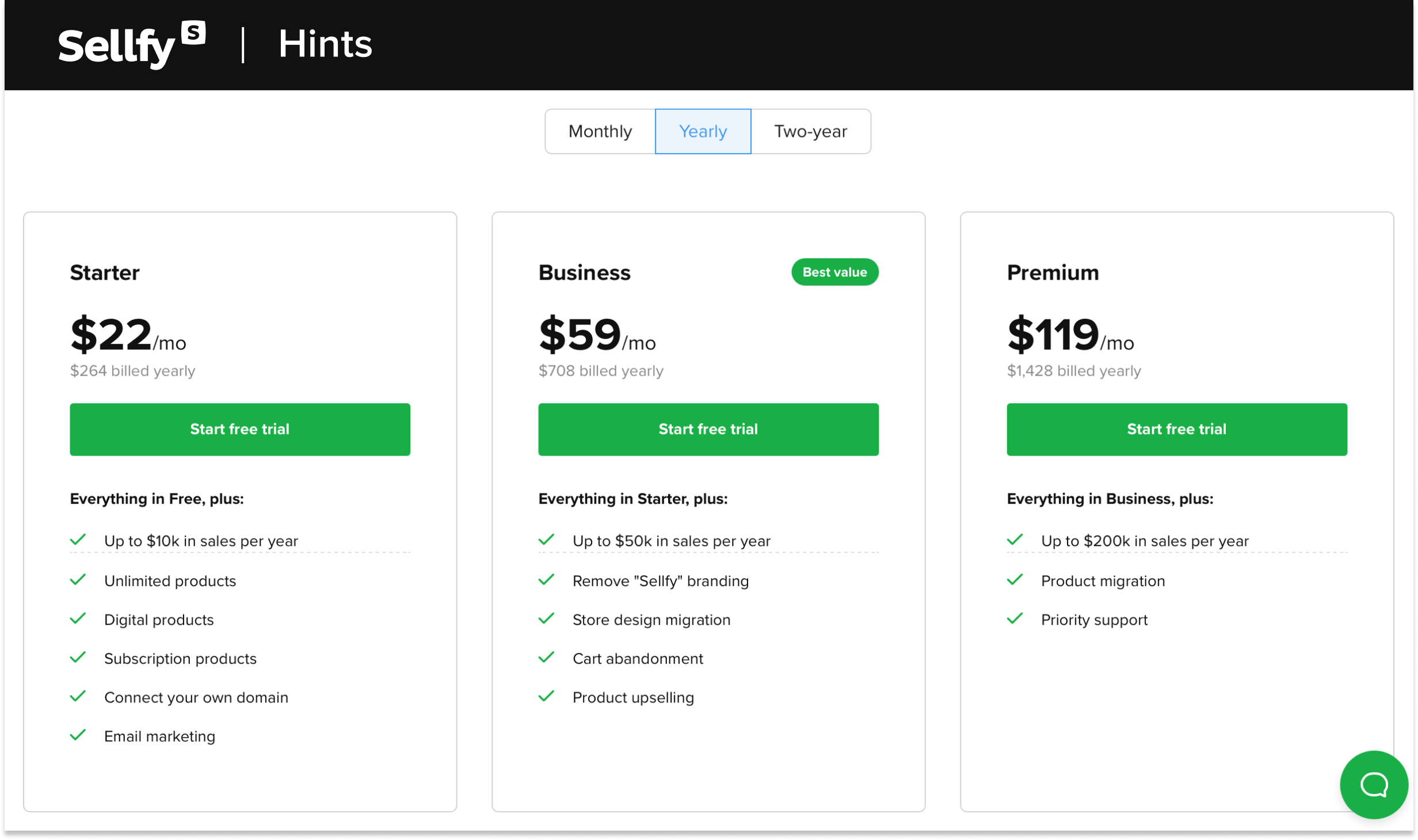
4. Sellfy’s customer support will always have your back
There’s nothing more important than good customer support when it comes to running an online store. Sellfy’s customer support team is available 24/7.
And, not only is the team available at any time, but they’re also incredibly helpful.
Sellfy creator and photographer Megan Hein agrees:
I was also blown away at how quick your customer support were to respond. I thought it would take a week or two before I heard back from them, but that immediate response kept my business up and running.
So, if you ever run into a problem, you know that you can rely on Sellfy’s excellent support team!
Make sure to check out more Gumroad and Shopify comparison articles:






